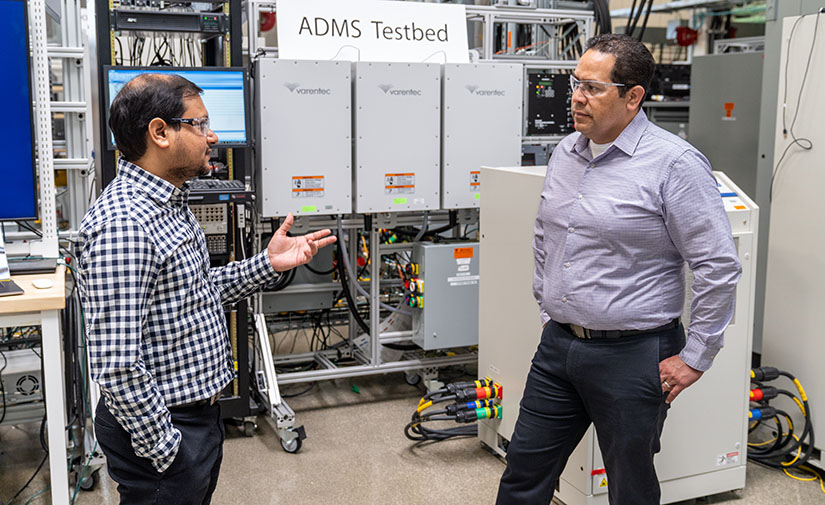Electric Utility Companies and Co-Ops Can Unleash the Grid Edge With This Unique NREL Asset
The ADMS Test Bed Is Behind Some of Today’s Most Advanced Distribution System Designs

Devices at the grid edge are potential assets for optimizing electrical distribution systems, and NREL’s Advanced Distribution Management System test bed helps industry realize benefits from these assets. Photo from Getty Images
Ever wonder how surplus power from rooftop solar panels could be shared with homes nearby? Or how dozens of electric vehicles charging from a building at the same time might stress the grid? These are the same questions that preoccupy utilities as they weigh their options for modernizing distribution systems.
But as some operators already know, there is a secret weapon for making the right distribution grid investments: the Advanced Distribution Management System (ADMS) test bed at the U.S. Department of Energy’s National Renewable Energy Laboratory (NREL).
The ADMS test bed has everything utilities need to model and evaluate their desired distribution systems: grid simulators, renewable energy generators, megawatt-scale distribution equipment, and electric system experts. These interconnected assets have allowed utilities and grid management software vendors to validate their next big investments or products—like private communication networks for utility devices or residential buildings that provide energy services. And the door is always open for new projects, with another round of user proposals recently announced.
A Common Use Case: Creating Value at the Grid Edge
Ready or not, renewable energy is reshaping the power system, predominantly at the “edge”—the end of the distribution line where customers are adding rooftop solar, electric vehicles, and plenty of other devices. With the right controls and applications, these devices can be an asset for grid operation. Whether the goal is to add resilience or increase the share of renewable energy, ADMS test bed use cases show the technical possibilities.
One ongoing focus for utilities is real-time control of distributed energy resources. Some years ago, NREL invented algorithms for real-time optimal power flow, and these have since been used regularly in ADMS test bed projects. Not long after the algorithms were created, a co-op in Colorado used the test bed and algorithms to model improvements to their distribution system resilience and renewable energy usage, ultimately finding that the algorithms helped to stabilize voltage and reduce cost for their ratepayers. The same co-op is returning to the ADMS test bed to attempt controls that dynamically reorganize the distribution system into resilient microgrids.
“Utility operators count on increased situational awareness to mitigate grid challenges and augment reliability and resilience,” said Ismael Mendoza, senior researcher at NREL.

The ADMS Test Bed uses a variety of renewable energy devices, control equipment, and grid simulators to validate technological solutions for utilities. Photo by Werner Slocum, NREL
Another area that often attracts test bed users is how to solicit services from grid edge devices. Think of a solar plant or commercial building that could return some of its remaining electricity to the grid to balance power conditions. The FAST-DERMS project involves Department of Energy laboratories and a few large utilities using the ADMS test bed to demonstrate controls for aggregating and coordinating distributed energy devices. This approach grants utilities flexibility when scheduling resources, so they can make use of devices that already exist on the grid for new value streams.
As use cases continue to roll through the ADMS test bed, its capabilities continue to be enhanced, such as the addition of IEEE 2030.5 protocol support through the FAST-DERMS project and the integration of NREL’s residential building simulation tool, OCHRE, for more granular representation of homes and their associated behind-the-meter resources.
Space To Evaluate Large, Interconnected Distribution Systems
Past ADMS test bed use cases span protection system modernization, peak load management, advanced metering infrastructure, transmission-distribution coordination, and much more. Now the test bed can validate the same applications, but at a higher power, with more real devices, and with more detailed simulations. This is possible with the buildout of NREL’s Advanced Research on Integrated Energy Systems (ARIES) platform.

The ARIES platform at NREL integrates multiple research environments, including the ADMS test bed, and hardware assets to provide users with highly realistic grid environments to validate new investments and technologies. Photo by Josh Bauer and Bryan Bechtold, NREL
ADMS test bed users now have access to 20 megawatts of hardware—solar panels, hydrogen electrolyzers, battery energy systems, etc.—for closer-to-reality experiments. Additionally, NREL’s cyber range can be integrated with the test bed to add a cyber-communications dimension, allowing users to visualize and track grid disruptions due to cyberattacks or communications failures to mitigate any potential attack vector.
“Utilities and partners are able to leverage the ADMS test bed capabilities to increase confidence in the performance of advanced functionalities in a controlled environment at scale before actual implementation, as well as identify any flaws, risk-free,” Mendoza said.
Current User Call
NREL has opened applications for users to once again propose ADMS test bed projects. The call addresses large-scale electric vehicle integration with the power system and focuses on control architectures, the role of aggregators, integration with buildings, and cyber-secure data architectures.
Stay tuned for more about the user call by subscribing to the ESI newsletter.
Last Updated May 28, 2025
